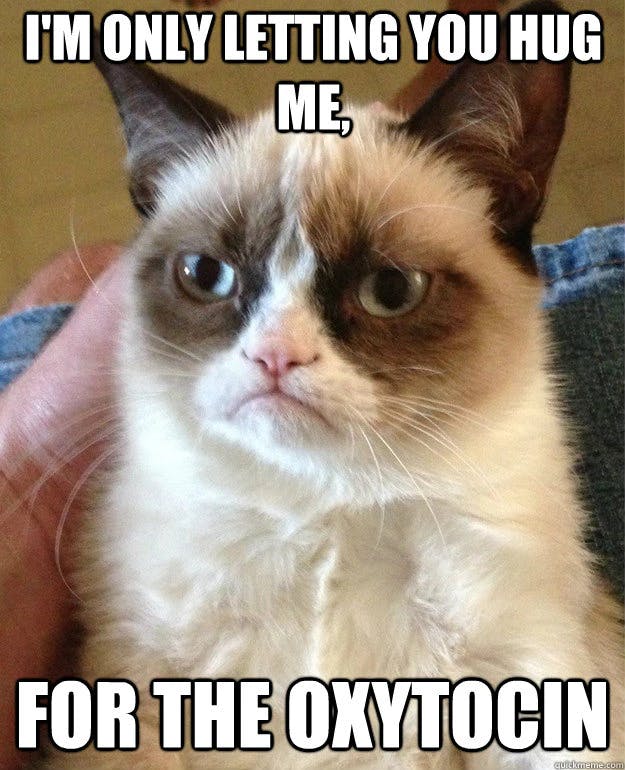Oxytocin: Everything You Need To Know About The "Love Hormone"
Poets and scientists have been investigating what makes human relationships tick for ages. One discovery that plays a crucial role in many kinds of relationships is the hormone oxytocin.

What Is Oxytocin?
Oxytocin is a hormone that plays many roles in our social interactions. It impacts our ability to bond, to trust others, and to interpret social cues.
Discovered in 1906 by Sir Henry Dale, this nine amino, peptide hormone was named oxytocin from the Greek words ωχνξ, τoχoxξ, meaning “swift birth.”
Here’s the nitty-gritty biology about it: Oxytocin is produced in the hypothalamus in the brain and is secreted into the bloodstream by the posterior pituitary gland. It’s also synthesized and secreted in the uterus, placenta, ovaries, and testes (yes, men have oxytocin too!). It can act as a chemical messenger in the brain, and it can act on the body, such as in organs like breasts and the uterus.

The production of oxytocin is controlled by a positive feedback loop, where the secretion of the hormone causes an action in the body that tells the body to make more of that hormone. For example, when uterine contractions during childbirth start, that tells the brain to make more oxytocin which causes more contractions. Once the baby is born, the contractions stop and the oxytocin production stops too.
Ok, so how does oxytocin impact us in our day to day life?
Oxytocin’s Role in Motherhood
Oxytocin was first discovered during research on the process of childbirth.
Childbirth and Breastfeeding
Oxytocin is a major player in labor and delivery. Leading up to childbirth, the number of oxytocin receptors in the muscles of the uterus greatly increases. When labor begins, both the brain and the uterus secrete oxytocin in large amounts, which tells the uterine muscles to contract, pushing the baby out of the womb, through the birth canal, and out into the world. (Sounds so easy on paper, right?)
A manufactured oxytocin, such as pitocin, might be administered to induce labor or to help it progress. Or it might be given to speed up the delivery of the placenta or to reduce the risk of excessive bleeding.
After the baby is born, oxytocin comes into play during breastfeeding. The stimulation of the nipples produces oxytocin, which promotes the movement of milk into the breast (what’s commonly called “let down”), allowing the baby to nurse.

Maternal Feeling and Parent-Child Bonding
Now that you (and oxytocin) have pushed your brand new little baby out into the world, oxytocin plays a new role — mother-baby bonding.
The impact of oxytocin in mother-baby bonding has been studied in both animals and humans. In studies with rats and with sheep, new mothers who were chemically deprived of oxytocin did not show normal maternal behavior. In another study, virgin female sheep were injected with oxytocin and put with unknown lambs, which they consequently treated as their own babies.
In a study with humans, the oxytocin levels of 62 pregnant women were tested throughout their pregnancy and first month postpartum. The women who had higher levels of oxytocin throughout did more bonding behaviors with their babies, such as “singing special songs or bathing and feeding their infants in specific ways.”
The amount of oxytocin you have can also impact the level of attachment for both the mother and the child.
But oxytocin doesn’t just impact the mother’s bond; it’s also an essential part of a child’s ability to attach and bond with their mother and others. A study comparing the oxytocin levels in children raised by their birth parents and children who were adopted from Russian and Romanian orphanages showed that after interactions between the child and mom oxytocin increased in the biological children but not in the adopted children. These findings suggest that low or unresponsive oxytocin levels play a role in inhibiting attachment, even when living with loving adopted parents.
Overall, these studies show that the presence or absence of oxytocin is clearly linked to the ability to bond with your baby, and the amount of oxytocin you have can also impact the level of attachment for both the mother and the child.
Oxytocin’s Role in Love and Sex
But before oxytocin is needed for labor and delivery, it’s active during the necessary precursor — sex.
Love, Orgasm, and Attachment
You’ve probably heard oxytocin referred to as the “love hormone.” It’s called that because it circulates at higher levels in the blood when you’re falling in love and it’s released in a surge during orgasm, in both men and women. Kissing, foreplay, hugging, and cuddling also trigger a rise in oxytocin.

But oxytocin would more accurately be called the “attachment hormone.” Think about it: the times when oxytocin is most at play – childbirth, breastfeeding, falling in love, sex – all these events are connected to a relationship. Oxytocin is there to cement the relationship and make it pleasant and loving and long-term, i.e. to bond. A mother-baby relationship without that loving attachment is unhealthy, especially for the baby’s development. Any long-term romantic relationship would be painful and dysfunctional without that loving attachment.
And here’s the thing: Your brain and body can’t tell the difference between sex with your spouse and casual sex in a one-night stand. To your brain and body, sex is just sex. Oxytocin will be released. Period. Which means that your brain is forming an attachment at some level – whether you want it to or not — because oxytocin creates and maintains bonds.

Monogamy
Because attachment is the primary factor in long-term relationships, oxytocin also plays a role in forming and maintaining monogamous relationships.
While women have naturally higher oxytocin levels than men, a 2013 study showed that oxytocin plays a role in helping men bond with their wives and stay monogamous. The study showed that when the men, who had been dosed with oxytocin, looked at images of their wife or girlfriend, her attractiveness was enhanced and he received a bigger dose of dopamine (a reward hormone) than when he looked at a strange woman. So basically, oxytocin makes you better-looking and more valuable in the eyes of your man!
Oxytocin makes you better-looking and more valuable in the eyes of your man.
In prairie voles, which mate monogamously for life, oxytocin is released in the female’s brain during mating which creates her bond with her partner. (In the male, the hormone vasopressin has a similar effect.)
Oxytocin’s Role in Social Bonds and Stress
Surely, that must be all oxytocin does? Nope. Not even close. Oxytocin is also involved in social bonds, in trust, and in reducing stress.
Trust and Generosity
Lab-based experiments have implicated oxytocin’s influence on your willingness to trust others and to be generous towards them. Men who were dosed with oxytocin displayed more trust and more generosity with money in two different money-based games played with strangers.
Communication and Social Cues
“Oxytocin is not the love hormone,” says Dr. Larry Young, of the Center for Translational Social Neuroscience at Emory University. “It’s tuning us into social information and allowing us to analyze it at a higher resolution.”
Several studies have shown that increased levels of oxytocin help those with autism to decrease their repetitive behaviors and to “retain the ability to evaluate the emotional significance of speech intonation.”
Oxytocin tunes us into social information and allows us to analyze it at a higher resolution.
Oxytocin also helps couples communicate better by increasing their emotional sensitivity. One study showed that couples who were dosed with oxytocin and then led into a disagreement were “able to communicate more effectively and to better de-escalate the situation than couples who had received a placebo.”
Stress
The findings about oxytocin’s role in trust, generosity, and social cues are pretty clear cut. But oxytocin’s role in stress seems almost contradictory.
On the one hand, studies have definitely shown that oxytocin counteracts the effects of cortisol. Breastfeeding mothers are calmer during stressful situations than bottle-feeding mothers. And getting comfort and a hug from your mom when you’re stressed — or even just talking to her on the phone — can raise your oxytocin and reduce your stress.

But on the other hand, other studies have shown that both oxytocin and cortisol levels are high in women who experienced social isolation and unhappy romantic relationships.
So how does that make jive? Well, what seems to be happening is that in times of low stress, oxytocin rewards your positive social bonds with feelings of attachment and trust, but in times of high stress, oxytocin pushes you to find other, better social connections.
Social psychologist and oxytocin researcher Dr. Shelley Taylor, director of UCLA’s Social Neuroscience Lab, says that, in these high-stress cases, “We don’t think it’s signaling, ‘stay close to that person,’ it’s signaling ‘stay close to someone’ because your bonds are threatened. Get social contact from somewhere.”
Closing Thoughts
So, since oxytocin seems to have all these relational and social benefits, should we try to get more of it? Should we spray ourselves with oxytocin-laced perfume in an effort to promote positive social interactions?
"Oxytocin is developing a reputation of being the sort of thing you'd want to dump in someone's coffee in the morning to make them soft and nice and fuzzy and good to you," Dr. Taylor says. "That's just not the case. Oxytocin is much more complex than that."